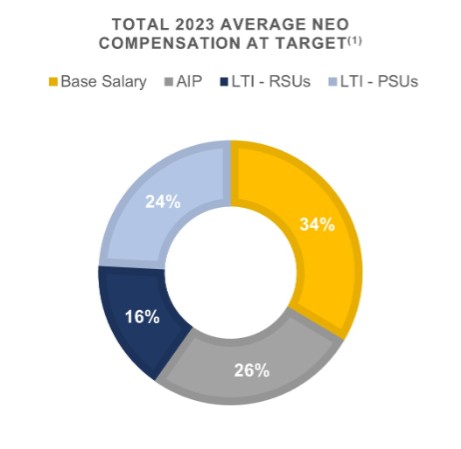adoption of the three lines governance model and the implementation of a culture of managing risk through our risk management processes, with a focus on the role of all employees in managing risk. It also outlines our risk management governance structure, including the roles of our Board, management, lines of business (including first line risk functions), independent risk management as the second line, and internal audit as the third line within the governance structure.
On a quarterly basis, we evaluate the existing risk profiles facing the Company by risk categories, against the Risk Appetite Statement to ensure that actual operations of the Company align within the Company’s risk appetite, both overall and on an individual risk category basis. The Risk Appetite Statement and Enterprise Risk Management Framework are reviewed and approved by the Board annually. Independent Board oversight of the Risk Appetite Statement and Enterprise Risk Management Framework and independent assessment by the Board of our risk profile against our Risk Appetite and Framework on a quarterly basis enable us to better serve our customers, deliver long-term value for our shareholders, and achieve our strategic objectives.
Our Chief Risk Officer, the Company’s senior-most risk manager, has a dual reporting structure, reporting both to the Chief Executive Officer of the Company and to the Board Risk Committee. The Chief Audit Executive reports to the Audit Committee and for administrative purposes, the Chief Executive Officer. This governance structure is designed to complement our Board’s commitment to maintaining an objective, independent Board and committee leadership structure over risk and controls.
Board Oversight of Cybersecurity Risk
Our Board recognizes the importance of protecting the data provided by the Company’s customers, clients, and employees and devotes significant time and attention to overseeing the strategies the Company employs to protect our data and systems and to mitigate against cybersecurity risk.
We have a cross-departmental approach to identifying, assessing, and managing cybersecurity risk, including input from employees and our Board of Directors (the "Board"). The Board and its Risk and Audit Committees (respectively, the “Risk Committee” and the “Audit Committee”), as well as senior management in, among other areas, the information security, information technology, operations, and risk management (including enterprise and operational risk) areas, devote significant resources to cybersecurity and risk management processes to adapt to the changing cybersecurity landscape and to identify and respond to cybersecurity threats and incidents in a timely and effective manner. Our cybersecurity risk management program leverages the National Institute of Standards and Technology (NIST) framework, which organizes cybersecurity risks into five categories: identify, protect, detect, respond and recover. We regularly assess the threat landscape and take a holistic view of cybersecurity risks, with a layered cybersecurity strategy based on prevention, identification, and remediation. Our information technology and information security areas review enterprise risk management-level cybersecurity risks continually, and key cybersecurity risks are incorporated into the Company’s Enterprise Risk Management Framework that supports its Risk Appetite Statement. In addition, we have a set of Company-wide policies and procedures concerning cybersecurity matters, such as policies related to encryption standards, antivirus protection, remote access, multifactor authentication, confidential information, and the use of the internet, social media, email and wireless devices. These policies go through an internal review process and are approved by appropriate members of management. On an annual basis, the Board approves the Company’s Information Security Policy and Program which provides a layered approach to cybersecurity, and includes administrative, technical, and physical safeguards designed to protect the security, confidentiality, and integrity of customer information in accordance with applicable law.
The Company’s Chief Information Security Officer (“CISO”) is responsible for developing and implementing our information security program and reporting on cybersecurity matters to the Company’s Chief Risk Officer (“CRO”), who oversees and supervises the risk function, including the information security, compliance, legal, operational (which includes business continuity, model risk, and third-party risk functions) and enterprise risk areas.
The Board includes a cybersecurity expert who chairs the Risk Committee and provides technology-related insight and guidance to the Company. As part of the Risk Committee’s responsibility for monitoring key business and regulatory risks, the Risk Committee receives from our CISO quarterly reports and materials which include a review of cybersecurity and information technology key risk indicators, test results and related remediation, and any recent cybersecurity threats or incidents and how the Company is managing those threats or incidents. The Risk Committee also periodically reviews reports on the threat environment, vulnerability assessments, results of penetration testing, and potential cybersecurity and data privacy incidents, as well as information on ongoing employee training relating to data privacy and cybersecurity and how to protect data against cyber threats. Further, on a quarterly basis, our CRO presents to the Risk Committee updates from our Director of Enterprise and Operational Management on the Company’s business continuity program, which covers, among other things, outages and incidences and disaster recovery and business continuity testing. The Risk Committee also approves the annual risk assessment required by the Gramm-Leach-Bliley Act. Moreover, the CISO follows a risk-based escalation process to notify the Risk Committee outside of the cycle of regular updates when management has identified an emerging risk or material issue related to cybersecurity. The Risk Committee also reports material cybersecurity risks to the full Board, based on our CISO’s assessment of risk. In addition, the Audit Committee reviews reports of the Company’s internal audit department’s periodic audits of our information security area and various components thereof.













































